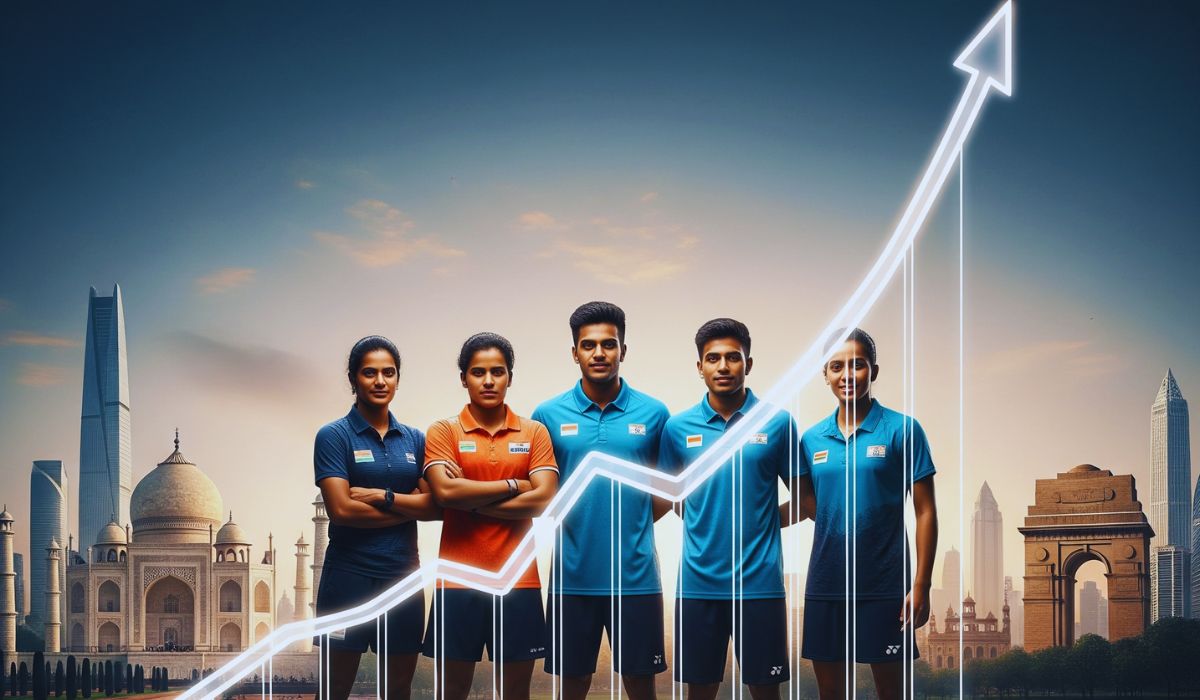- “From Rackets to Riches? The Ugly Truth About Badminton Salaries in India”
When we think of sports stars in India, cricket takes center stage. The glitz, endorsements, and colossal paychecks dominate headlines. But beyond the cricketing frenzy lies a world of unspoken dedication — the badminton courts, where Indian shuttlers train, sweat, and rise with sheer determination. Yet, the big question lingers: Do badminton players in India really earn enough to match their hard work?
If you’re someone who’s ever wondered what fuels a badminton career in India — the earnings, the struggles, the behind-the-scenes realities — you’re in the right place. This article pulls back the curtain on the financial journey of Indian badminton players. From national heroes to rising hopefuls, we explore who earns what, where the money comes from, and why this sport is both a passion and a financial puzzle for many.
Let’s dive deep into the numbers, the hope, and the harsh truth behind the badminton player salary in India.
The Star Salaries: What Top Indian Badminton Players Actually Earn
At the pinnacle of Indian Salaries of Badminton Players, players like P.V. Sindhu, Saina Nehwal, and Kidambi Srikanth have become household names. Their success on the global stage has attracted sponsorships, prize money, and endorsements, turning them into millionaires.
For instance, P.V. Sindhu’s earnings reportedly exceeded ₹50 crore annually during her peak years, thanks to brand endorsements with companies like Bridgestone, JBL, and Gatorade. She’s also among India’s highest-paid female athletes, beating even some male sports stars in endorsements.
However, this level of Salaries of Badminton Players income is limited to the top 1% of players. For every Sindhu or Saina, hundreds of players are grinding away with far less financial security.
Prize Money: A Win-Or-Nothing Game
Prize money forms a large chunk of Salaries of Badminton Players income for Indian badminton players. Major BWF tournaments like the All England Open, Indonesia Open, and BWF World Tour Finals offer significant rewards — but only for those who perform consistently.
- Winning a Super 1000 tournament can earn Salaries of Badminton. a player between $70,000 to $100,000.
- A Super 300 event may pay Salaries of Badminton Players $7,500 to $15,000 for winners.
- National tournaments in India offer far less — often just a few lakhs for the winner.
The catch? Players must self-fund their travel, training, and equipment in most cases. So unless they win consistently, expenses often outweigh earnings.

Government Support and Incentives
To promote sports beyond cricket, the Indian government has rolled out schemes under the Ministry of Youth Affairs and Sports.
Top performers get:
- Monthly stipends under Khelo India
- Awards like Arjuna and Rajiv Gandhi Khel Ratna, which come with cash prizes
- Support from the Target Olympic Podium Scheme (TOPS)
A Commonwealth Games gold may earn a player ₹20 to ₹30 lakh in government rewards, depending on the state.
Still, these are one-time bonuses. They do not ensure steady Salaries of Badminton Players income, especially for mid-level or injured players.
The Role of Sponsorships: Game Changer for Elite Players
For elite athletes, endorsements provide stability. Companies like Yonex, Li-Ning, Red Bull, and Gatorade are always looking for rising talent to support. These sponsorships cover gear, travel, training, and sometimes even salaries.
For instance:
- Sindhu’s deal with Li-Ning was reportedly worth ₹50 crore over 4 years
- Kidambi Srikanth and others also have lucrative gear and brand deals
But these deals are mostly reserved for world-ranked players or Olympic hopefuls. Upcoming players usually get free equipment or limited sponsorships — barely enough to cover costs.
Private Leagues: A New Income Source
The now-defunct Premier Badminton League (PBL) offered Indian players a new revenue stream. Top Indian Salaries of Badminton players were auctioned for ₹30 to ₹70 lakh per season, depending on their international ranking.
Although the league is on hold, if revived, it could again be a significant earning platform. It also raises visibility, helping players attract more endorsements.
Without such leagues, many players rely solely on tournaments and government schemes — making their Salaries of Badminton Players and earnings unpredictable.
The Hidden Struggles of Upcoming Players
While national champions live a high-profile life, aspiring players and juniors face a financial uphill battle. Many come from small towns and modest families. Their parents often mortgage homes or take loans to support travel and training.
An upcoming shuttler may need:
- ₹8 to ₹15 lakh per year for international exposure
- ₹3 to ₹5 lakh annually for coaching, nutrition, and physiotherapy
Without sponsors, these costs fall on families — pushing talented players to the edge of quitting. Despite talent, lack of money kills many careers before they bloom.
Academies and Their Financial Support
Top academies like Pullela Gopichand Academy and Prakash Padukone Badminton Academy provide partial or full support to selected players. This includes:
- Training facilities
- Nutritionists and doctors
- Some travel sponsorships
But they only take in a few players. The rest have to pay high fees or depend on crowdfunding. While these academies produce champions, they can’t serve the masses — leaving many deserving players out.
Salaries from Government Jobs: A Safety Net for Some
Many badminton players are recruited under the sports quota by:
- Indian Railways
- Petroleum companies (ONGC, Indian Oil)
- Banks and Public Sector Units
These jobs offer Salaries of Badminton Players from ₹30,000 to ₹80,000 per month, depending on experience and designation. They also provide job security, a rarity in sports.
For many players, this Salaries of Badminton Players income is the only reliable source that helps sustain their sporting career.
Comparison with Other Sports: Still a Long Road Ahead
Compared to cricket, tennis, or even kabaddi, Salaries of Badminton Players still lags behind in terms of Salaries of Badminton Players earnings. A mid-tier cricketer in the IPL makes more in one season than most badminton players make in a lifetime.
Even Indian kabaddi stars earn ₹20 to ₹70 lakh per Pro Kabaddi season.
Badminton’s prize money, sponsorships, and visibility still need a push to make it a financially viable career for the masses.
Income from Coaching After Retirement
Once players retire, some become coaches — either in private academies or as part of national teams. Coaching jobs can pay:
- ₹40,000 to ₹1.5 lakh/month, depending on expertise and location
- Top coaches like Pullela Gopichand earn more via academy ownership and brand collaborations
While it’s a secure path, not every former player becomes a coach. Many fade into anonymity or switch careers entirely, especially if they didn’t earn enough while playing.
Social Media and Online Platforms: A New Hope
In today’s digital age, several shuttlers build personal brands on YouTube, Instagram, and coaching apps.
- They offer paid tutorials
- Share fitness routines
- Conduct online workshops
This trend gives Salaries of Badminton Players a secondary income source and helps them stay visible even when they’re not actively competing.
Women Players and Gender Pay Disparity
Though Salaries of Badminton Players is one of the few sports with equal prize money for men and women, women still face unique challenges.
- Fewer sponsorships due to media bias
- Pressure to quit post-marriage
- Lack of institutional support for maternity breaks
P.V. Sindhu and Saina Nehwal broke many barriers, but grassroots support for women is still lacking, affecting their earning potential.
Corporate Sponsorships: The Tipping Point for Visibility
Corporate houses can change the game. If big brands invest in nurturing young talent, badminton salaries could see exponential growth.
Imagine if every state had a corporate-sponsored league, or if local companies supported junior players with kits and travel — the sport would see sustainable income for thousands, not just a lucky few.
How Media Coverage Impacts Salaries
Media plays a vital role in player popularity — and therefore, earnings. Unfortunately, badminton often gets attention only during Olympics or major wins.
Regular coverage of tournaments, interviews, and stories can:
- Attract sponsors
- Create fan bases
- Boost player confidence and negotiation power
Lack of coverage = lack of commercial value = lower salaries.
The Harsh Reality: Talent Isn’t Always Enough
In India, raw talent doesn’t guarantee a financial future. Unless you’re a top-10 player, you’re likely juggling:
- Training
- Finding sponsors
- Worrying about travel money
This stress impacts performance and mental health. Without robust financial Salaries of Badminton Players systems, talent often dies in silence.
Passion vs. Paycheck — Is It Worth It?
Salaries of Badminton Players in India is filled with brilliant stories of courage, sacrifice, and discipline. But behind every medal is a family that struggled, a coach who gave free hours, and a player who kept going despite financial hurdles.
The current Salaries of Badminton Players structure favors a handful. For real change, we need systemic support — from the government, corporates, and society. Only then can we ensure that passion doesn’t come at the cost of poverty.
For now, becoming a professional badminton player in India is not just a dream — it’s a risk. But for those who dare, the rewards can be emotional, even if not always financial.
The Shifting Landscape of Badminton Salaries in India
Badminton in India has transformed over the last decade. Once a niche sport, it now enjoys a strong following thanks to players like PV Sindhu, Saina Nehwal, and Kidambi Srikanth. But behind the medals and headlines lies a reality many don’t see—player salaries in India vary dramatically. Some players live a life of comfort, traveling internationally, backed by sponsors. Others, even at the national level, struggle to cover travel and equipment costs. It’s a space where the glamour often masks the grind.
How Much Do Top-Tier Indian Badminton Players Actually Earn?
Elite Indian badminton players, especially those representing the country in major tournaments, can earn anywhere Salaries of Badminton Players from ₹30 lakhs to over ₹5 crores annually. These numbers come from a mix of tournament winnings, government cash rewards, endorsements, and league contracts like those in the Premier Badminton League (PBL). PV Sindhu, for instance, reportedly earned over ₹10 crores in a single year due to endorsement deals with brands like Li-Ning and Bridgestone. But that’s the top 1%. The remaining players have a very different story.
The Stark Divide: Top Players vs Upcoming Talent
One of the most painful truths in Indian badminton is the Salaries of Badminton Players income gap. Top players have strong financial backing from sponsors and government Salaries of Badminton Players and incentives. They fly business class and train in world-class facilities. But upcoming players—even those in national camps—often have to pay their own way for domestic travel, stringing racquets, and buying shuttlecocks. Many talented youngsters drop out simply because they cannot afford the cost of chasing their dream.
Prize Money: A Double-Edged Sword
Prize money sounds attractive, but it’s inconsistent and unpredictable. Winning a national tournament might earn a player ₹1 to ₹3 lakhs, which must last months. International wins bring more, but even reaching those tournaments can be expensive. You have to fund your training, physio, travel, stay—and only if you win, do you get anything back. For most Salaries of Badminton Players, the risk often outweighs the reward.
Sponsorship: The Real Game-Changer
The presence or absence of sponsorship defines a player’s financial stability. Salaries of Badminton Players sponsored by brands like Yonex, Li-Ning, or Victor get free equipment, clothes, and sometimes stipends. These deals are usually performance-based. Young players who show promise in junior tournaments sometimes get small sponsorships, but they’re rare. Without one, the costs of gear and travel are a massive burden.
Government Support: A Lifeline or a Mirage?
The Indian government does provide Salaries of Badminton Players support to badminton players through schemes like TOPS (Target Olympic Podium Scheme), which gives stipends, world-class training, and more. However, only a few athletes qualify. State governments sometimes offer cash rewards, but the process can be slow and bureaucratic. Unless you’re an Olympic medalist or have media visibility, financial support is often lacking or delayed.
Premier Badminton League (PBL): A Ray of Hope
The PBL revolutionized badminton earnings in India. Top players are auctioned and signed by franchise teams. Salaries of Badminton Player sin the PBL range from ₹3 lakhs to ₹80 lakhs per season. PV Sindhu was once signed for over ₹80 lakhs. Young players also get noticed here and can earn around ₹3 to ₹10 lakhs Salaries of Badminton Players. While PBL gives short-term financial relief, it only lasts a few weeks in a year, and not every player gets signed.
Coaching, Academies, and Side Incomes
Many mid-level and retired players Salaries of Badminton Players turn to coaching for a stable income. They either join existing academies or start their own. Some even offer private training for Salaries of Badminton Players ranging from ₹500 to ₹3000 per session. It’s a good source of income, but it often comes at the cost of their own game. Balancing coaching and competitive play is tough, and many have to choose between passion and practicality.
The Role of Brand Endorsements
Salaries of Badminton Players Only a handful of Indian badminton players get lucrative brand endorsements. PV Sindhu is the highest-paid female athlete in India partly due to her brand partnerships. Saina Nehwal too had deals with Herbalife and Edelweiss. These deals bring crores in income, but such opportunities are usually reserved for Olympic medalists or world-ranking players. Most players, even if nationally ranked, rarely get such exposure
Travel and Training Costs: The Silent Killer
Even before you start earning, you need to spend. Daily court fees, shuttlecocks, racquets, coaching, gym, nutrition, and physio add up to thousands per month. International travel can cost ₹1.5 to ₹3 lakhs per tournament, including visas and airfare. Unless you’re funded, this amount comes from the Salaries of Badminton player’s or their family’s pocket. Many families take loans or exhaust savings to support their children’s ambitions
Youth Players: High Hope, Low Pay
India has a huge pool of young badminton talent, many of whom win national junior titles. But for most, income is non-existent. Their only hope is to be picked by academies like Prakash Padukone Academy or Gopichand Academy, which sometimes sponsor training. Even then, only a fraction get any financial support. Until they break into the senior circuit or land a PBL contract, they often depend entirely on their families.
Gender Pay Gap in Indian Badminton?
Interestingly, badminton in India is one of the few sports where female players often earn more than male counterparts, thanks to higher global rankings and brand appeal. PV Sindhu and Saina Nehwal have both out-earned male players in endorsements and league earnings. However, this is again limited to just a couple of athletes and not reflective of the broader picture.

Foreign Exposure and Its Cost
To grow, Indian players need exposure to international coaching and tournaments. But training abroad—say in Denmark, Indonesia, or Malaysia—can cost upwards of ₹5 lakhs per stint. Without federation or sponsor backing, this is out of reach for most players. Yet, players who make that investment often show faster improvement, creating a frustrating divide between the privileged and the passionate.
Corporate Jobs for Players: A Hidden Safety Net
Some public sector companies like ONGC, Indian Oil, and Railways offer jobs to badminton players under the sports quota. These roles offer monthly salaries of Badminton Players between ₹25,000 to ₹75,000 and allow players time off for tournaments. It’s a reliable income source, and Salaries of Badminton players rely on these roles to survive. But competition is stiff, and selection often favors those with medals or national titles.
Fame vs Fortune: Not Always Aligned
Many badminton players are known locally, get featured in media, or have large social followings. But fame doesn’t always bring fortune. Some players have thousands of followers and play internationally, but struggle to make ends meet. Until badminton becomes commercially viable for more than just the top Salaries of Badminton 5 players, this contradiction will continue.
Emotional Toll of Financial Insecurity
Beyond numbers, the stress of financial instability can crush even the most talented players. Young athletes carry the burden of their family’s investment and expectations. They travel to tournaments unsure if they’ll even break even. The psychological strain of chasing both performance and livelihood often leads to burnout and early retirement.
The Future: Is There a Brighter Side?
The good news is that things are changing. With increased media attention, digital sponsorships, and a growing badminton fan base, more financial opportunities are emerging. New tournaments, streaming deals, and online coaching platforms are giving players extra avenues to earn. But for this to become sustainable, the system needs to support not just the stars but also the strugglers.
Final Thoughts
The journey of a Salaries of Badminton player in India is one of passion, perseverance, and patience. The rewards can be great, but only for a few. For many others, the road is lined with sacrifices, uncertainty, and grit. As fans and stakeholders, understanding the financial realities of these athletes is the first step toward creating a healthier, more inclusive ecosystem.

